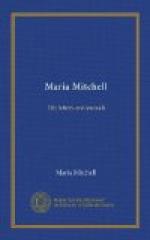“October 23. Another dinner-party at the observatory, consisting of the Struves, General and Mrs. Sabine, Professor and Mrs. Powell, Mr. Main, and ourselves; more guests coming to tea.
“Mrs. Airy told me that she should arrange the order of the guests at table to please herself; that properly all of the married ladies should precede me, but that I was really to go first, with Mr. Airy. To effect this, however, she must explain it to Mrs. Sabine, the lady of highest rank.
“So we went out, Professor Airy and myself, Professor Powell and Mrs. Sabine, General Sabine and Mrs. Powell, Mr. Charles Struve and Miss S., Mr. Main, Mrs. Airy, and Professor Struve.
“General Sabine is a small man, gray haired and sharp featured, about seventy years old. He smiles very readily, and is chatty and sociable at once. He speaks with more quickness and ease than most of the Englishmen I have met. Mrs. Sabine is very agreeable and not a bit of a blue-stocking.
“The chat at table was general and very interesting. Mr. Airy says, ’The best of a good dinner is the amount of talk.’ He talked of the great ‘Leviathan’ which he and Struve had just visited, then anecdotes were told by others, then they went on to comic poetry. Mr. Airy repeated ‘The Lost Heir,’ by Hood. General Sabine told droll anecdotes, and the point was often lost upon me, because of the local allusions. One of his anecdotes was this: ’Archbishop Whately did not like a professor named Robert Daly; he said the Irish were a very contented people, they were satisfied with one bob daily.’ I found that a ‘bob’ is a shilling.
“When the dinner was over, the ladies left the room, and the gentlemen remained over their wine; but not for long, for Mr. Airy does not like it, and Struve hates it.
“Then, before tea, others dropped in from the neighborhood, and the tea was served in the drawing-room, handed round informally.
“August 15. Westminster Abbey interested me more than I had expected. We went into the chapels and admired the sculpture when the guide told us we ought, and stopped with interest sometimes over some tomb which he did not point out.
“I stepped aside reverently when I found I was standing on the stone which covers the remains of Dr. Johnson. It is cracked across the middle. Garrick lies by the side of Johnson, and I thought at first that Goldsmith lay near; but it is only a monument—the body is interred in Temple churchyard.
“You are continually misled in this way unless you refer at every minute to your guide-book, and to go through Europe reading a guide-book which you can read at home seems to be a waste of time. On the stone beneath which Addison lies is engraved the verse from Tickell’s ode:
“‘Ne’er to these chambers where the mighty rest,’ etc.
“The base of Newton’s monument is of white marble, a solid mass large enough to support a coffin; upon that a sarcophagus rests. The remains are not enclosed within. As I stepped aside I found I had been standing upon a slab marked ‘Isaac Newton,’ beneath which the great man’s remains lie.




